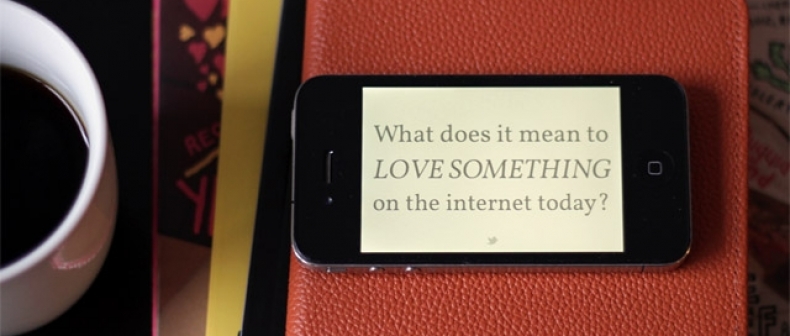
Credit: robinsloan.com
What does it mean to love something on the internet? On a medium that, by design or not, often lends itself to skimming across a surfeit of words and images, we know what it means to like something – to fave it, to star it, to give it the proverbial thumbs up. But what about love?
It’s that question which has elicited Fish, an essay-meets-iPhone-app by writer and media inventor, Robin Sloan. It would be a shame to rob you of the pleasure of reading Fish, and if you care about the issues at all–and have an iPhone or iPad–you should stop reading now and download the free app when you can. But for those without iDevices, a quick recap: the app-essay requires you to tap to move forward, and there is no back button. Taps can reveal a new page or just the next word in a sentence. The subject of the essay is the glut of good stuff to read and watch online. It is “an endless flood” of great stuff, which Sloan, noting The Atlantic, Kottke.org, The New Iniquiry and more, suggests is “almost cruel”. And it is.
It would thus be easy to look at Sloan’s experimental mini-essay as a valorization of print. It would also be a mistake. As is pointed out in the app, the problem with the web is not that it’s full of fluff. It’s that, done right, there’s too much that is smart and interesting. The question is how to hold on to any of it.
So Sloan turns to his central metaphor: fish. It stems from the story of historian Louis Agissiz. He would put students in a room with a fish on a metal tray and tell them to look at it, for hours on end. Though they would become exasperated, he would send them back again, and tell them to keep looking–at which point they would then start to uncover a startling plethora of details. The idea is both simple and profound: when we return to something repeatedly, we discover anew. We rarely return to anything online. So: an iPhone essay called “Fish”.
It is clearly a kind of call to arms, but not an isolated one, or a mere droplet amidst the flood. Among the many things Sloan has become renowned for is a post on his group blog, Snarkmarket, entitled Stock and Flow. Google it, and you’ll see it’s an idea other people also keep returning to again and again, itself a bit of interesting meta-ness. In the post, Sloan outlines how the economic idea of stock and flow-–where stock is stuff of static value and flow is the rate of change–is actually also the central metaphor for modern media: that flow is the endless digital flood, and stock is the durable stuff that has a significantly greater half-life.
It’s an idea I’ve also returned to a lot, in large part because, though a completely committed digiphile, I too have been feeling as if I just can’t hold to things that really move me. For me, stock and flow has become a question of anchors and floods: of the pleasant, inspiring rush of things and the tools and methods we use to pin certain ideas down. If it is anchors we are searching for, they are two sorts: one to hold the things we experience in place; and another, a touch more desperate, to attach ourselves to, lest we get lost in the ceaseless torrents.
For some time now, I’ve thought of things this way: of digital as the flood and physical as the anchor. I may watch Netflix endlessly, but I will buy aching French drama Summer Hours on Blu-Ray so that I can return to it again, with the kind of patience and attention it deserves. Though I tend to roll my eyes when purists wax rhapsodic about, say, the metaphorical weight of the book, its coarse paper pushing back against our fingertips, the heft of physicality has certain uses in the 21st century. It impinges, it demands. It insists upon itself.
But what Fish seems to suggest is that physical is only one kind of anchor–and that we need a digital one, too. We often think about the focus of physical in terms of space: the book, bounded off from all others, thus warranting attention all on its own. But it seems we need to figure out what digital boundedness look like. On screens that are always morphing into something else, delimiting borders is a difficult thing. Digital edges are, by their nature, ineffable and prone to disappearing. So rather than space, what it seems Sloan is arguing here is that we also need to think of how digital reading object might rope off or mark out time: of how we might carve out a temporal anchor in the flood of things that take up figurative space in our minds.
What is encouraging, then, is the glimpse of answers to these heady questions. There is a push or weight to Fish that comes from its form. The idea of reading employed is one loosely borrowed from video games: press here to continue the story. Because you must tap the screen to move forward and continue reading, it demands attention from you. Unlike a stream of tweets, or a TV show, it does not flit by as you find yourself distracted by the way the wind is moving the tree in your yard. It is in that way like reading in general, but also an indication of how digital media needs to adapt to the constrains of attention. We need to give people a reason to not look away.
Most pressing of all those demands is that there is no going back. Once you’ve read Fish, you’ve read Fish. It is, in its unrepeatable nature, media-as-event, another favourite “Sloanian” idea. And in that paradoxical tension–in the impossiblity of an absolute return; but the obvious need that we must return over and over again–is, it seems, the only place any hope lies.
____
Navneet Alang is a tech critic at Toronto Standard. Follow him on Twitter at @navalang.
For more, follow us on Twitter at @torontostandard, and subscribe to our newsletter.














